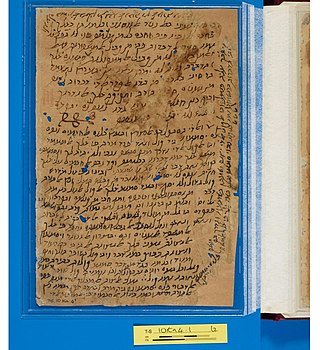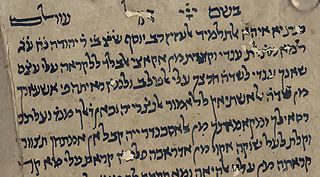
Hebrew is a Northwest Semitic language within the Afroasiatic language family. A regional dialect of the Canaanite languages, it was natively spoken by the Israelites and remained in regular use as a first language until after 200 CE and as the liturgical language of Judaism and Samaritanism. The language was revived as a spoken language in the 19th century, and is the only successful large-scale example of linguistic revival. It is the only Canaanite language, as well as one of only two Northwest Semitic languages, with the other being Aramaic, still spoken today.
Hebrew grammar is the grammar of the Hebrew language.
Jacob ben Abba Mari ben Simson Anatoli was a translator of Arabic texts to Hebrew. He was invited to Naples by Frederick II. Under this royal patronage, and in association with Michael Scot, Anatoli made Arabic learning accessible to Western readers. Among his most important works were translations of texts by Averroes.

Moses ben Maimon (1138–1204), commonly known as Maimonides and also referred to by the Hebrew acronym Rambam, was a Sephardic rabbi and philosopher who became one of the most prolific and influential Torah scholars of the Middle Ages. In his time, he was also a preeminent astronomer and physician, serving as the personal physician of Saladin. He was born and lived in Córdoba in al-Andalus within the Almoravid Empire on Passover eve 1138 or 1135, until his family was expelled for refusing to convert to Islam. Later, he lived in Morocco and Egypt and worked as a rabbi, physician and philosopher.

Jewish philosophy includes all philosophy carried out by Jews, or in relation to the religion of Judaism. Until modern Haskalah and Jewish emancipation, Jewish philosophy was preoccupied with attempts to reconcile coherent new ideas into the tradition of Rabbinic Judaism, thus organizing emergent ideas that are not necessarily Jewish into a uniquely Jewish scholastic framework and world-view. With their acceptance into modern society, Jews with secular educations embraced or developed entirely new philosophies to meet the demands of the world in which they now found themselves.

The Kuzari, full title Book of Refutation and Proof on Behalf of the Despised Religion, also known as the Book of the Khazar, is one of the most famous works of the medieval Spanish Jewish philosopher, physician, and poet Judah Halevi, completed in the Hebrew year 4900 (1139-40CE).

Judeo-Arabic dialects are ethnolects formerly spoken by Jews throughout the Arab world. Under the ISO 639 international standard for language codes, Judeo-Arabic is classified as a macrolanguage under the code jrb, encompassing four languages: Judeo-Moroccan Arabic (aju), Judeo-Yemeni Arabic (jye), Judeo-Egyptian Arabic (yhd), and Judeo-Tripolitanian Arabic (yud).

Samuel ben Judah ibn Tibbon, more commonly known as Samuel ibn Tibbon, was a Jewish philosopher and doctor who lived and worked in Provence, later part of France. He was born about 1150 in Lunel (Languedoc), and died about 1230 in Marseilles. He is best known for his translations of Jewish rabbinic literature from Arabic to Hebrew. Samuel ibn Tibbon wrote his own philosophical works, including "Sefer ha-Mikhtav", which dealt with ethics and spirituality. Samuel ibn Tibbon's translations and commentaries had a significant impact on Jewish thought and scholarship during the Middle Ages. They helped to disseminate the ideas of Greek philosophy and Islamic science throughout the Jewish world, and they also contributed to the development of Jewish philosophy in their own right.
Ibn Tibbon is a family of Jewish rabbis and translators that lived principally in Provence in the 12th and 13th centuries.

Solomon ibn Gabirol or Solomon ben Judah was an 11th-century Andalusi poet and Jewish philosopher in the Neo-Platonic tradition. He published over a hundred poems, as well as works of biblical exegesis, philosophy, ethics and satire. One source credits ibn Gabirol with creating a golem, possibly female, for household chores.

The Guide for the Perplexed is a work of Jewish theology by Maimonides. It seeks to reconcile Aristotelianism with Rabbinical Jewish theology by finding rational explanations for many events in the text.

David Kimhi (1160–1235), also known by the Hebrew acronym as the RaDaK (רַדָּ״ק), was a medieval rabbi, biblical commentator, philosopher, and grammarian.
Moses ben Jacob ibn Ezra, known as Ha-Sallaḥ was an Andalusi Jewish rabbi philosopher, linguist, and poet. He was born in Granada about 1055 – 1060, and died after 1138. Ibn Ezra is considered to have had great influence in the Arabic literary world. He is considered one of Spain's greatest poets and was thought to be ahead of his time in terms of his theories on the nature of poetry. One of the more revolutionary aspects of Ibn Ezra's poetry that has been debated is his definition of poetry as metaphor and how his poetry illuminates Aristotle's early ideas. The impact of Ibn Ezra's philosophical works was minor compared to his impact on poetry, but they address his concept of the relationship between God and man.

Hebrew literature consists of ancient, medieval, and modern writings in the Hebrew language. It is one of the primary forms of Jewish literature, though there have been cases of literature written in Hebrew by non-Jews. Hebrew literature was produced in many different parts of the world throughout the medieval and modern eras, while contemporary Hebrew literature is largely Israeli literature. In 1966, Agnon won the Nobel Prize for Literature for novels and short stories that employ a unique blend of biblical, Talmudic and modern Hebrew, making him the first Hebrew writer to receive this award.
Jonah ibn Janah or ibn Janach, born Abū al-Walīd Marwān ibn Janāḥ, , was a Jewish rabbi, physician and Hebrew grammarian active in al-Andalus. Born in Córdoba, ibn Janah was mentored there by Isaac ibn Gikatilla and Isaac ibn Mar Saul, before he moved around 1012, due to the sacking of the city by Berbers. He then settled in Zaragoza, where he wrote Kitab al-Mustalhaq, which expanded on the research of Judah ben David Hayyuj and led to a series of controversial exchanges with Samuel ibn Naghrillah that remained unresolved during their lifetimes.
Solomon ben Abraham ibn Parhon was a Spanish philologist of the 12th century, a native of Ḳal'ah, Aragon. In the preface to his lexicon he mentions as his teachers, besides a certain R. Ephraim of whom nothing more is known, the two great Spanish scholars Judah ha-Levi and Abraham ibn Ezra. Ibn Parḥon refers also to conversations with Judah ha-Levi, mentioning, for example, his remarkable assertion regarding the inadmissibility of meter in Hebrew poetry, and tells of the sojourn of Ha-Levi and Ibn Ezra in North Africa.
Moses ibn Tibbon was a Jewish physician, author and translator in Provence. The number of works written by Moses ibn Tibbon suggest that he reached a great age.
Jewish Kalam was an early medieval style of Jewish philosophy that evolved in response to Kalam in Islam, which in turn was a reaction against Aristotelianism.
Hartwig HirschfeldMRAS was a Prussian-born British Orientalist, bibliographer, and educator. His particular scholarly interest lay in Arabic Jewish literature and in the relationship between Jewish and Arab cultures. He is best known for his editions of Judah Halevi's Kuzari—which he published in its original Judeo-Arabic and in Hebrew, German and English translations—and his studies on the Cairo Geniza.

Isaac ben Melchizedek, was a rabbinic scholar from Siponto, Italy, and one of the first medieval scholars to have composed a commentary on the Mishnah, of which only his commentary on Seder Zera'im survives. Elements of the Mishnaic order of Taharot are also cited in his name by the Tosafists, but the complete work is no longer extant.










